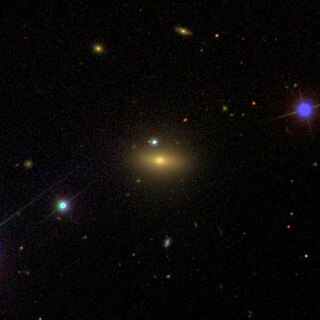
NGC 5886 is an +14 magnitude elliptical galaxy in the constellation Boötes. It was originally discovered by John Herschel on 13 May 1828 with an 18.7 inches (470 mm) reflector.
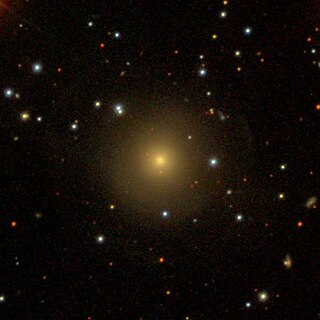
NGC 7315 is a lenticular galaxy in the constellation of Pegasus. It was discovered on 11 September 1872 by Édouard Stephan. It was described as "very faint, extremely small, round, brighter middle" by John Louis Emil Dreyer, the compiler of the New General Catalogue.
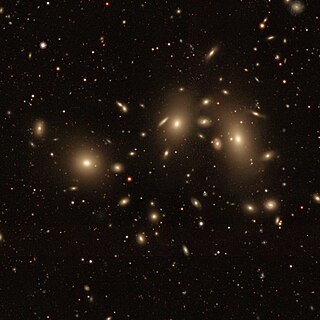
NGC 7499 is an unbarred lenticular galaxy within the constellation Pisces. NGC 7499 is its New General Catalogue designation. It was discovered on September 2, 1864 by the astronomer Albert Marth.

NGC 352 is a barred spiral galaxy in the constellation Cetus. It was discovered on September 20, 1784 by William Herschel. It was described as "pretty faint, small, irregularly extended" by John Louis Emil Dreyer, the compiler of the New General Catalogue; he also noted an "8th magnitude star 97 seconds of time to east" relative to the galaxy.

NGC 6850 is a barred lenticular galaxy in the constellation Telescopium, discovered by John Herschel in 1836.

NGC 124 is a spiral galaxy in the constellation Cetus. It was discovered by Truman Henry Safford on September 23, 1867. The galaxy was described as "very faint, large, diffuse, 2 faint stars to northwest" by John Louis Emil Dreyer, the compiler of the New General Catalogue.
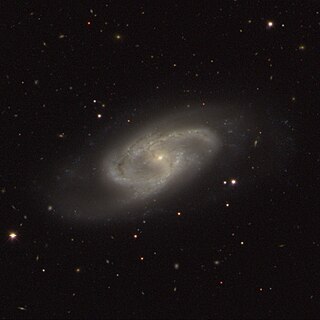
NGC 150 is a barred spiral galaxy in the constellation Sculptor. It is about 70 million light years away from the Solar System, and it has a diameter of about 55,000 light years. It was discovered on 20 November 1886, by Lewis A. Swift. The Type II supernova SN 1990K was detected in NGC 150, and was reported to be similar to SN 1987A.
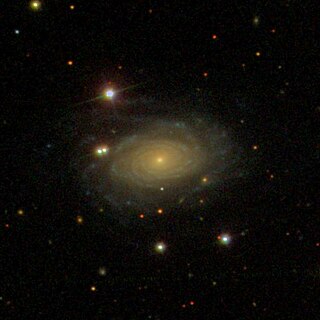
NGC 251 is a spiral galaxy in the constellation of Pisces. It was discovered on October 15, 1784, by Frederick William Herschel.

NGC 252 is a lenticular galaxy located in the constellation Andromeda. It was discovered by William Herschel in 1786.

NGC 5002 is a Magellanic spiral galaxy in Canes Venatici. It was discovered by Heinrich d'Arrest in 1865. It is also known as MCG 6-29-51, PGC 45728, UGC 8254.

NGC 1573 is an elliptical galaxy in the constellation of Camelopardalis. It was discovered on 1 August 1883 by Wilhelm Tempel. It was described as "very faint, small" by John Louis Emil Dreyer, the compiler of the New General Catalogue. It is located about 190 million light-years away.

NGC 5559 is a barred spiral galaxy, located 240 million light-years away in the constellation of Boötes. It was discovered on April 10, 1785, by the astronomer William Herschel.

NGC 3697 is a spiral galaxy in the constellation of Leo. It was discovered on 24 February 1827 by John Herschel. It was described as "extremely faint, very small, extended 90°" by John Louis Emil Dreyer, the compiler of the New General Catalogue. It is a member of HCG 53, a compact group of galaxies.
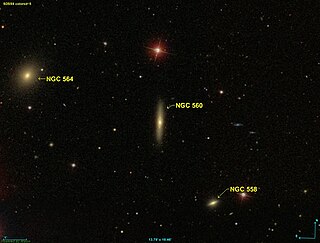
NGC 560 is a lenticular galaxy in the constellation Cetus. It is estimated to be about 250 million light-years from the Milky Way and has a diameter of approximately 150,000 light years. It is part of the Abell 194 galaxy cluster. NGC 560 was discovered on October 1, 1785 by the German-British astronomer William Herschel.

NGC 550 is a spiral galaxy in the constellation Cetus. It is estimated to be about 300 million light-years from the Milky Way and has a diameter of approximately 110,000 light years. The German-British astronomer William Herschel discovered it on 8 October 1785.

NGC 812 is a spiral galaxy located in the Andromeda constellation, an estimated 175 million light-years from the Milky Way. NGC 812 was discovered on December 11, 1876 by astronomer Édouard Stephan.

NGC 813 is a lenticular galaxy in the constellation Hydrus. It is estimated to be 390 million light-years from the Milky Way and has a diameter of approximately 140,000 ly. NGC 813 was discovered on November 24, 1834, by the British astronomer John Herschel.

NGC 941 is an intermediate spiral galaxy in the constellation Cetus. It is an estimated 16.83 MPc from the Milky Way and has a diameter of approximately 55,000 light years. The galaxies NGC 926, NGC 934, NGC 936, NGC 955 are located in the same sky area. NGC 941 was discovered by the astronomer William Herschel on 6 January 1785.

NGC 644 is a barred spiral galaxy in the constellation Phoenix in the southern sky. It is estimated to be 270 million light-years from the Milky Way and has a diameter of approximately 130,000 light-years. Together with NGC 641, it probably forms a gravitationally bound pair of galaxies. The object was discovered on September 5, 1834 by John Herschel.

NGC 3254 is a spiral galaxy in the constellation Leo Minor. It was discovered on March 13, 1785, by the astronomer William Herschel. It is a member of the NGC 3254 Group of galaxies, which is a member of the Leo II Groups, a series of galaxies and galaxy clusters strung out from the right edge of the Virgo Supercluster.




















